The census journey to work dataset contains a wealth of data, but analysis of this data is rarely published. This post includes 16 maps showing the concentrations of different modes in the journey to work in Melbourne as recorded in the 2006 Census.
About the maps
Before jumping into the maps, I need to state a few things and disclaimers:
- All of these maps are based on the home Census Collection District of each worker who travelled to work.
- Many of the maps show Melbourne’s tram, train and high (AM) peak frequency bus networks as of 2006. High frequency buses are those with an average AM peak headway of less than 20 minutes (not including 20 minutes – which makes it a somewhat arbitrary cut-off). There may be minor omissions in the display of the bus network, particularly where several bus routes overlap to provide a high frequency corridor, so use this as a guide only.
- I’ve filtered out larger sized CCDs on the assumption they are most likely to be non-urban areas. However some smaller non-residential areas are still present in the results (perhaps they shouldn’t be, but I haven’t really got the time to redo all the maps).
- The colour scales vary for each map and are based on quintiles with rounding. I’ve aimed to highlight variations within each mode, so the same colours will mean different mode shares on different maps.
- Click to enlarge the maps to see more detail.
Much of the commentary in this post will assume some geographic knowledge of Melbourne, apologies for that. But I have included some links to Google Maps to show you places I am talking about.
High level modal shares
The first map shows the share of journeys work involving public transport (and possibly also private transport and/or bicycle).
You can see:
- Large areas of high mode share in the inner suburbs. In particular the inner northern suburbs (Brunswick) and inner south-eastern suburbs (St Kilda/Malvern to South Yarra) where there is a dense frequent public transport network in most directions.
- Some points of relatively high mode share in the middle and outer suburbs around train stations (but not always around train stations).
- A high mode share in the area around the Monash University Clayton Campus – though note the area north of the campus is largely industrial so this might be misleading.
- Very low mode share in the outer suburbs in areas away from train stations and high frequency bus routes, indicating high car dependence.
- Low mode share in the CBD and immediate surrounds (related to a large number of destinations being in walking distance, more on this below).
- There are some frequent bus routes in the outer suburbs that still have low public transport mode share. These services may be focussed on moving school children, but also many of them do not provide fast direct travel in a radial direction. For example,
- Route 476 through Keilor has a number of deviations off the main road and then gets caught in congestion on Keilor Road before reaching Essendon Station.
- Route 477 from Broadmeadows to Essendon via Airport West is highly indirect and also gets caught in congestion before reaching Essendon Station.
- A couple of the bus routes north of Ringwood Station are quite indirect.
- Some of the north-south bus routes in East Doncaster are indirect.
- Route 571, which largely serves Epping to South Morang, has a large one way loop around Centenary Drive making it less direct for some people. Although for many people it is direct. This bus route operates a “TrainLink” service between Epping and Plenty Valley Town Centre – meeting every train at Epping, seven days a week.
The next maps shows mode share of car-only journeys to work.
You can see:
- Lower car mode shares around train stations and through the inner and middle suburbs where better public transport is available.
- Very high car mode share in the outer suburbs where public transport service levels are poor.
- Low car mode share around Monash University Clayton campus, Deakin University Burwood campus, Latrobe University Bundoora, the Simpson Army Barracks in Yallambie (near Greensborough)
The next chart shows people using active transport – that is walking only or any journey involving a bicycle (and possibly other modes).
This map shows:
- A remarkably circular region around the CBD with high active transport mode share (though it seems to extend a bit further north into Brunswick).
- Pockets of high mode share around Footscray, Broadmeadows, Box Hill, Ringwood, and Frankston – which have all since been nominated as Central Activities Districts (CADs).
- Pockets of high mode share around suburban university campuses – suggesting concentrations of staff living within walking distance (note: journey to work is not supposed to include journey to education). The Victorian Police Academy in Glen Waverley also shows up.
- A few unexpected concentrations:
- in West Reservoir (between the Upfield and Epping train lines). This is a lower socioeconomic residential area adjacent to (and in some cases mixed in with) a light industrial area, which is something planners have been actively avoiding in recent times. But this historical land use pattern seems to facilitate a high share of people walking to (presumably local) employment.
- Some pockets around off-rail major shopping centres – eg Highpoint, Werribee Plaza, Altona Gate, Southland, Cranbourne.
Putting together active and public transport, the following chart shows the mode share of “sustainable” transport modes:
Not unexpectedly, it shows high sustainable transport mode share in the inner city – with active transport taking over from public transport as you approach the CBD.
A more detailed look at each mode
Trains
The next map shows the share of journeys to work involving train (and in many cases other modes as well).
Unsurprisingly there are concentrations around train stations, but also:
- Very low train mode share in the Doncaster/Manningham corridor – where freeway buses operate to the CBD. This suggests few people driving to train stations from this region.
- A low mode share between the Upfield and Epping train corridors in Brunswick/Northcote – where there are several very frequent tram services that are often competitive with train travel times.
- Some higher concentrations at the western edge of the north-western suburbs, which were very poorly served by public transport in 2006. This might represent a pocket of park (car) and ride (train) commuters.
- A concentration stretching west from Newport station more than typical. Perhaps a high number of people catching buses to Newport station? More on that below.
Limiting the analysis to train (and walking) only journeys produces the following map:
While there are concentrations around train stations, there are above 3% shares in areas well beyond reasonable walking distance of stations. While a few people might actually be walking several kms to a station, I’d suggest it is more likely to reflect a tendency for people to fail to report ALL modes used in their journey to work. Perhaps these people have a perception that the “obvious” way to reach a train station is by car and so the car leg was not worth reporting on the census form. An issue for people designing census forms.
Note there is the same concentration we saw on the previous map at the western edge of the north-western suburbs.
These off-rail “train only” concentrations actually correspond with people who report using both car-as-driver and train, as shown on the following map:
Some observations:
- There are high concentrations in the middle eastern and southern suburbs, including along tram route 75. These areas are just outside fare zone 1, so perhaps they involve people driving to from zone 2 homes to zone 1 stations to take advantage of cheaper fares to the city. But it also might reflect the lower service levels of local buses for reaching the train network.
- There are many pockets of concentration in the outer western and northern suburbs, particularly on the fringe of the urban area where bus services may not have existed at the time. There have been employment shortages in the western suburbs of Melbourne with a higher share of journeys to the inner city.
What about feeder modes to trains? The next chart shows people using both bus and train:
There are some interesting localised pockets:
- Newport west shows a high bus-train mode share – routes 432 and 471 operate in this area feeding Newport station (both every 20 minutes in the AM peak). Ironically there used to be a train station at Paisley in the south-west corner of the green pocket but it has been closed for several decades.
- There are many high frequency bus routes between Sunshine and Footscray and this area shows up quite clearly.
- East of Essendon station along Buckley Street (route 465) and between Moonee Ponds and Aberfeldie (route 467) there are high concentrations of bus-train commuters. Route 465 is timetabled to meet every train during the day (including the peaks) and route 467 also runs a high frequency in peak periods designed to meet trains. This strategy of high frequency bus feeder services is clearly highly successful at attracting bus-train commuters. (If only there were more such routes in Melbourne!)
- There are concentrations north (and to some extent south) of Box Hill station. A number of relatively high frequency routes converge in this area.
- There is an area around Monash University Clayton campus – which probably doesn’t represent people working at that campus as you can’t use a train to travel the short distance.
- The bus routes north of Ringwood station do appear to facilitate a relatively high number of bus-train commuters, despite some route indirectness (the mode share drops further from Ringwood where commuters endure more of the indirectness).
- South of Blackburn and Nunawading stations – where SmartBus routes operate to the south of these stations. The high frequency bus service appears to be attracting bus-train commuters.
- Around Warrigal Road, south of Holmesglen and Oakleigh stations – again probably the impact of the high frequency SmartBus route (then route 700, now 903).
- Around Doveton (east of Dandenong), where four bus routes each running approximately every 45-50 minutes converge to provide an average 12 minute service for most of the day on a weekday.
- Curiously around Pakenham, where hourly bus routes operated in 2006 with a limited span of hours.
- Some pockets west of St Albans station, where there are some places with overlapping bus routes (however they only run every 40 minutes).
The next map shows people using both trains and trams. While there is a smattering of such people across Melbourne (probably reflecting people changing onto trams after arriving in the inner city by train), I have zoomed into the tram network area to look for areas where tram feeds trains.
Some clear corridors are visible:
- Route 59 from Airport West to Essendon station
- Routes 70 and 75 along Riversdale Road (feeding Hawthorn and Burnley or Richmond presumably)
- Route 67 feeding Carnegie and Elsternwick stations from the east
- Route 3 feeding Caulfield station from the east
- Route 3 and 69 (now 16) feeding Balaclava station from the east
- Route 70 feeding Riversdale station from the east
- Route 19 adjacent to the Upfield train line (not sure what is going on here as the routes are parallel!)
- Route 82 into Footscray station
- Routes 112 and 86 where close to the Epping line (again, not sure what this would be as the routes are parallel)
- Route 69 (now 16) feeding Glenferrie and Kooyong stations
- Routes 57 and 59 feeding Flemington Bridge or Newmarket Stations (though I’ve not observed many people boarding trains at Flemington Bridge myself).
Note that route 75 does not act as an effective feeder to the Alemein train line – most likely because there is no station conveniently located to allow an easy interchange between these lines (probably a product of historical competition between modes).
Trams
The next map shows journeys involving tram (and possibly other modes). Again, I have zoomed in around the tram network.
There are several interesting things to note:
- The highest concentrations of tram use are in the northern suburbs (north to Brunswick area particularly), east to Richmond, and south to Port Melbourne, South Melbourne, Albert Park and St Kilda.
- A more moderate tram mode share is achieved in the inner south-eastern suburbs, likely due to the area also being well serviced by trains.
- The outer reaches of the tram network are generally not very effective at attracting a high tram mode share – particularly tram 86 to Bundoora, tram 75 to Vermont South, and tram 64 to East Brighton. These outer reaches provide long travel times to the jobs-rich inner city. This evidence does not support the case for outward extensions of the tram network. That said, tram 86 serves two universities in Bundoora and tram 75 serves Deakin University Burwood campus, so the trams probably attract a fair share of journeys to education. Unfortunately the census does not include journey to education.
The next map shows journeys to work involving tram (and walking) only:
This map is very similar, except that there is a low tram-only mode share where tram lines cross train lines before reaching the city centre. Refer to the map above on train + tram journeys.
Buses
The next map shows journeys to work involving buses (and possibly other modes):
This map shows several bus hot spots in Melbourne:
- The Sunshine-Footscray corridor which is served by several high frequency bus routes, and much of which is beyond walking distance of train stations.
- The Doncaster/Manningham area, which is served by several high (peak) frequency bus routes that run along the Eastern Freeway into the city (using bus lanes to get around congestion).
- North Altona along Millers Road. Bus route 232 runs every 10 minutes (or better) in peak periods across the Westgate Bridge into the city.
- A pocket around Monash University Clayton campus, which is only served by buses (however note much of the green area is industrial land so this may be misleading).
- Around Oriel Road in Heidelberg West where there is a (combined route) high frequency bus service to the city and Latrobe University Bundoora.
- Some patches around central Dandenong, where some bus routes overlap to provide a higher frequency combined service.
For completeness, the following map shows bus (and walking) only journeys:
Cycling
The following map shows the concentrations of journeys to work involving bicycle. I’ve zoomed in on the inner city as most of the rest of the Melbourne has very low bicycle mode share.
There is a very strong concentration in the inner northern suburbs – in the City of Yarra and the southern part of the City of Moreland (Brunswick). This area is very well served by high quality on road bicycle facilities. In many areas, over 1 in 10 journeys to work involve cycling.
Walking only
The next map shows concentrations of walking-only journeys to work:
Again, the inner city area has a high concentration, but there are also concentrations around major education campuses and larger activity centres in the suburbs.
Car passenger
The next map shows the mode share of “car as passenger” as part of the journey to work. This effectively shows a combination of car pooling and lift-giving trips.
The highest concentrations are in the outer suburbs (particularly in newer areas), where public transport service levels are lowest, but also many areas with lower incomes. I’d suggest it is likely that car passenger trips are a product of lower incomes (lower car ownership?) and/or poor public transport provision where lift giving is required. A pure lift giving trip is highly time inefficient for the driver, and the vehicle travels twice the distance that the passenger needs to travel – roughly doubling the congestion and environmental impacts. However, the car passenger trips might be partial car pooling – eg a driver drops a passenger at a train station on the way to work, which is relatively efficient.
I hope these maps are useful.
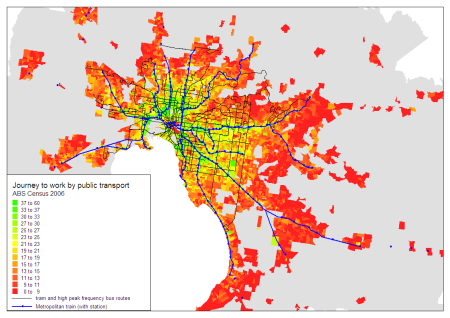

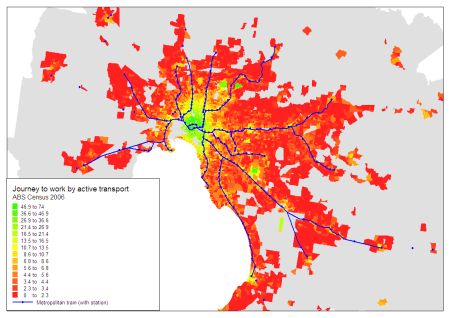
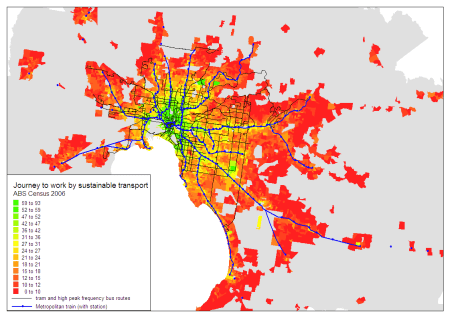
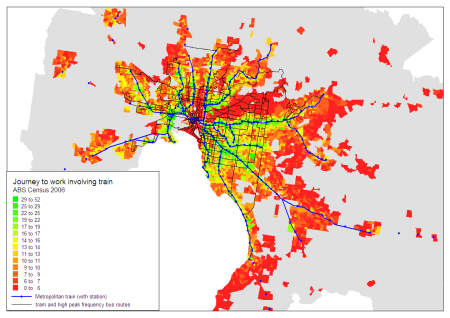
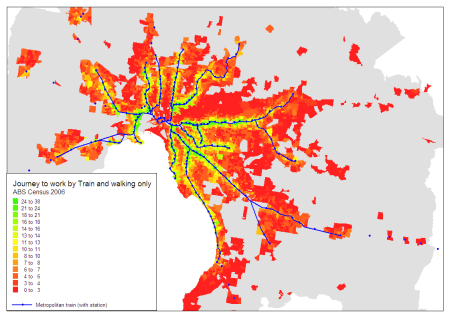
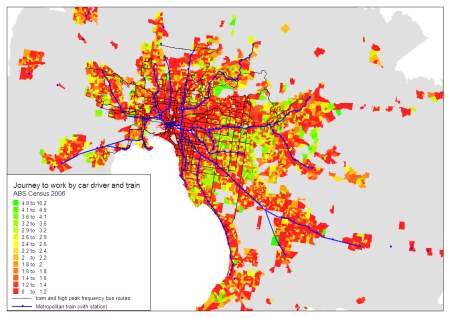
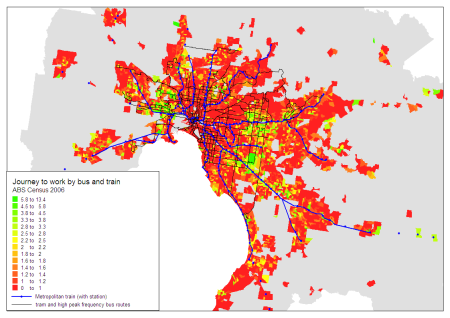
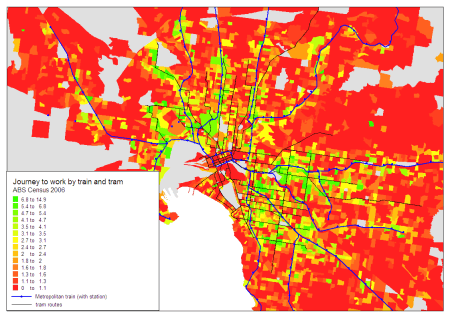
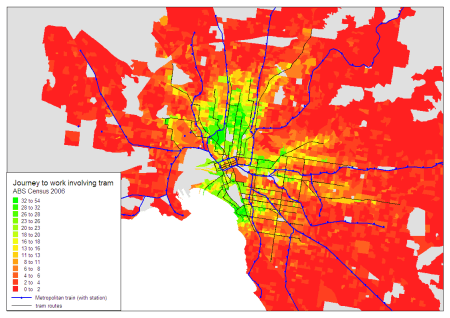

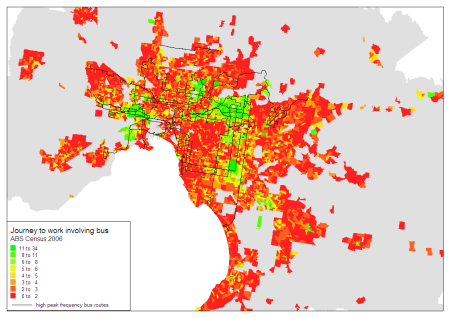
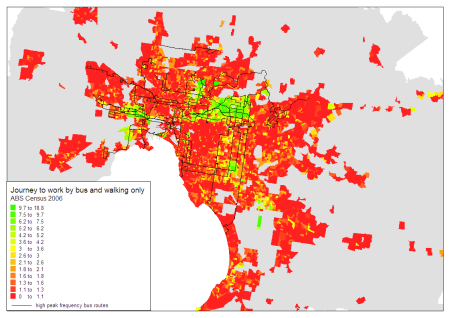
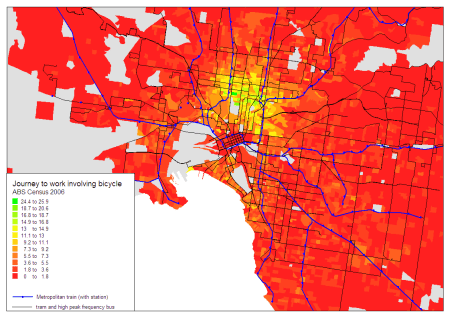

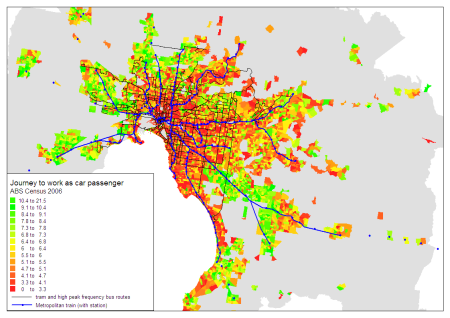

Hi Chris, interesting analysis once again – and I can see a lot of data crunching went into this.
The one nitpick I have is with your remark that low mode share toward the ends of long suburban tram routes works against the case for further tram extensions. The problem at present with these routes is they terminate in the middle of nowhere, so obviously patronage peters out at the far end because there are no destinations to attract people. The way to boost utilisation of these lines is to extend them just far enough that they terminate somewhere useful.
The classic case is of course the route 6 tram to Glen Iris, which terminates at the top of a hill, half a mile away from the nearest railway station. If you were to add that last half mile of track to connect the route to the station, then not only would you get a bunch of new passengers using the tram to access the station and nearby shops, you would also boost patronage on the existing part of the line because people would use it in both directions.
Likewise, the 67 tram terminates two blocks away from Carnegie station and the Koornang Rd shops, while the 64 East Brighton terminus has no shops, railway stations or other attractions of any sort within a couple of kilometres. The cost that has been sunk into extending the routes this far would be recovered by extending them just a bit further to cater for a much greater variety of trips.
LikeLike
Tony, I know what you are saying about tram routes that just fall short of somewhere useful. Probably a product of modes being in competition in the past.
However there is one example where a tram extension does go somewhere useful – the 109 to Box Hill, which is a major train station, bus interchange (albeit with a short walk required to change modes) and now a Central Activities District. However the same low tram mode share is visible at the end of this line.
LikeLike
[…] article in Charting Transport. This entry was posted in Reports & Publications, Research and tagged Charting Transport, […]
LikeLike
[…] transport mode share to employment areas In another post, I’ve mapped out the transport mode shares by residential origins. These maps are fairly […]
LikeLike
Really interesting work you’ve done here. Well done!
As a Sydneysider, I’ve always wondered if there’s anywhere I could get information like this for my hometown. Any chance you know somwhere that has this, and if not whether you’d ever get round to doing something like this for other cities?
LikeLike
The ABS Social Atlas publications include simple maps of mode share. Eg here is Sydney: http://www.abs.gov.au/ausstats/abs@.nsf/mf/2030.1/
You can get all the journey to work data for Sydney from the Bureau of Transport Statistics’ free “BTS Data Online” service: http://www.bts.nsw.gov.au/Home/default.aspx
Some more detailed maps of Adelaide mode shares for 2001 are available at: http://www.planning.sa.gov.au/index.cfm?objectId=0F5425BD-F203-0D46-A2C0F4BE12B42B83
Hope this helps.
LikeLike
[…] In cities like Melbourne, private transport remains the dominant mode of transport. While walking, cycling and public transport account for the majority of trips taken within the city’s CBD and inner suburbs, the vast majority of overall trips across the entire city are by private car (for information on transport mode share broken down by geographical location, see here). […]
LikeLike